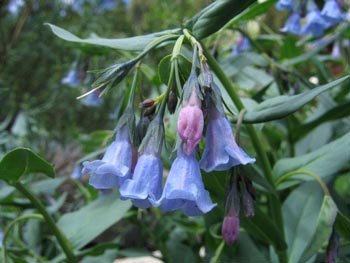Aspen Bluebells

Common Name(s):
Aspen Bluebells
Tall bluebells
Alpine Bluebells
Scientific Name:
Mertensia arizonica Greene
Scientific Name Synonyms:
None Known
Symbol:
MEAR6
Description:
Life Span: Perennial
Origin: Native
Growth Characteristics: Aspen bluebells is a tall perennial forb, erect to ascending, with one to several stems. Growth occurs slowly, with seedlings requiring a growing period of 2 or 3 years before flowering the first time.
Flowers: Flowers of bluebells are blue and nodding. There are several in branched, open clusters. The blossoms are ½ inch or more long, bell-like, nodding, and blue with tinges of pink. The bottom flowers will mature first, with the top flowers being the last to mature.
Fruits/Seeds: Nutlets, in fours.
Leaves: The basal leaves of bluebells, when present, are elliptic or oval, generally not heart-shaped, and long stalked. Stem leaves are alternate, only slightly reduce upward, and lance-shaped.
Stems: Numerous Stems, 1 to 3 feet tall.
Roots: Several main roots extend vertically from the caudex, with many fine lateral roots growing from each. Once established, roots may reach depths of 7 feet.
Ecological Adaptions:
Aspen bluebells is found in moist canyons, along streamsides, or moist meadows in pinyon-juniper, mountain brush, ponderosa pine, and spruce-fir communities. It can be found at elevations of 5000 to 11,000 feet.
Soils: Moist
Associated Species: Engelmann’s Spruce, Sub-alpine fir, aspen, Slender Wheatgrass, Smooth brome
Uses and Management:
Aspen Bluebells can produce up to 3,000 pounds/acre. It is eaten by both cattle and sheep.

